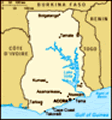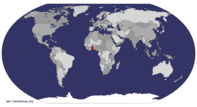Advertisement
Published: March 23rd 2009
At 7am on Saturday, our CIEE leaders arrived at the apartment with a small bus to drive us the five hours to Kumasi. Kumasi is the second-largest city in Ghana (behind Accra) and is the heart of the Ashanti region, which used to be an empire that encompassed a large portion of West Africa hundreds of years ago. Ashantis now mostly reside in southern Ghana -- most of my Ghanaian friends and CIEE leaders are Ashanti -- and still have a lot of pride in their history. The Ashanti king, or "Asantehene" in Twi, is still very powerful. As Mr. Gyasi, our fearless leader, explained, "If he tells Ashantis to go to bed at six pm every night, they will do it." A command from King Osei Tutu II, the current Asantehene, trumps one from President Mills. This means that the Ghanaian government must be in communication with the king (as well as less powerful kings of less prevalent ethnic groups) in order to prevent conflicts of interest. Fortunately, the current king's popularity and influence seems well-justified. According to those I have spoken with, he is a good man with the well-being of Ashantis, and Ghanaians as a whole, as his
primary motivation. He recently started a scholarship fund for underprivileged children and it has provided education for a large number of kids in the Ashanti Region. Also, anyone can meet with the king if they so desire and can speak with him about whatever they want, though I imagine the waiting list is rather long.
The first thing we did in Kumasi was to visit the Ashanti palace, which was surprisingly modest, and museum. We could not go inside the palace (or even take pictures of it) but the peacocks that greeted us at the front gate were evidence of royalty. A young woman guided us around the museum and gave us a brief history of the Ashanti kingdom, from the expansion of their empire throughout the entire 18th century to the decline of their power in the late 19th century due to British colonization. The rich traditions of the Ashantis encompass everything, including art, politics, music, and familial life; their culture is very sophisticated. Walking around the museum, I could clearly see why present-day Ashantis have such pride in their history.
After leaving the palace, we went to Kejetia Market. I had thought that Makola Market in Accra was crazy, but Kejetia's craziness level far surpasses that of Makola. My friend Becky and I wandered through the narrow labyrinthine paths that wound their way through hundreds if not thousands of stands selling everything imaginable, from shoes to cleaning supplies to fabric to live chickens. And everywhere we went: "Obroni! Come buy from me! I give you good price because you are my friend!" And to Becky: "China! Japan!" (She is Korean-American.) The things shouted at us were no different from those we receive in Accra everyday but they were more intensified due to the sheer density of shopkeepers packed into such cramped spaces. It was very overwhelming. We eventually fought our way out of the maze and found Mr. Gyasi and his wife standing on the balcony of a nearby building. We joined them and were treated to an amazing, expansive view of the market from our vantage point.
After spending a pleasant night at a very nice hotel (with air conditioning!), the group reconvened in the morning for breakfast. That day we traveled several miles outside Kumasi to the villages of Ntonso and Bonwire, the birthplaces of adinkra cloth and kente cloth, respectively. Adinkra cloth is primarily worn to funerals but the adinkra symbols are ubiquitous and often printed on kente cloth. Each symbol has a philosophic meaning. Two of the most common are
Gye Nyame ("except God" -- nothing can be done without God) and
sankofa ("back to the roots" -- don't forget our history as a people). The
Gye Nyame symbol is even printed on Ghana's 100-cedi bills. In Ntonso, a man named Peter showed us how the dye used for adinkra symbols is made by boiling bark from the badie tree. We each were given a turn at mashing the bark with a large stick. We then each chose one or two adinkra stamps for ourselves, bought a strip of kente cloth, and were shown how to stamp the dye onto the cloth. I stamped a strip of blue and green kente cloth with the symbols for forgiveness and hope.
While our strips of cloth were drying in the sun, we talked with some kids who lived in the village and some of us joined a football (or soccer) game already in progress. I was enjoying talking to a very nice ten-year old boy named David (I think that was his name) and playing his Sonic the Hedgehog handheld game with him until I realized that he and his friends expected me to have gifts for them. I gave them some pens for them to use for homework (pens are a common request here) but when they asked for money, I refused. Though they don't enjoy the comforts to which the average American is accustomed, it was clear that these kids were not destitute or hungry. They expect any visiting obroni to have bottomless pockets. I don't blame them at all for this misconception. The America they see on TV and in movies is one of wealth and luxury. And more than that, they are correct in their assessment that I have more money than they do, money that they could likely use more than I could. A few months ago I would have gladly given them a few ceids, Maybe this trip has hardened me slightly and made me more cynical. However, I prefer to think that I am merely less naïve. After witnessing the living conditions of children at the Osu Children's Home where I volunteer, the kids in Ntonso seemed extremely fortunate. Most if not all of them have loving families and a place to call home, two privileges that I no longer take for granted.
After Ntonso, we went to Bonwire to buy kente cloth. Coincidentally, my Twi professor is from Bonwire and is one of the more prominent kente weavers in Ghana. He has even designed fabric for a few of Ghana's past presidents and then presented it to them ceremonially. He was supposed to meet us in Bonwire to show us around but he couldn't make it. We didn?t learn of the reason for his absence until Twi class the following week. He explained to us that the chief of Bonwire had recently passed away and the residents of the village were looking for a new chief. They decided that my Twi professor was the best choice. Well, he had no desire to become chief -- it's too much responsibility, he explained, and it would take away from time he would rather spend teaching, writing, and planning a school for students with learning disabilities -- so he hid from the people looking for him. Apparently, if the first choice for new chief refuses, force is sometimes used against them. He did not tell us all of the details but when the men from his village came to coerce him (by presumably beating him), he escaped by pretending to be hurt and unconscious and then jumping out of a window and hiding in a crowd of people! He is now unable to return to Bonwire until the second choice (someone who was glad to receive the honor) is officially made chief. He has told us some other equally exciting, if not more exciting, stories in Twi class, one of which involves being a political prisoner and eventually exiled from Ghana during the oppressive regime of Jerry Rawlings, his former close friend, over a deecade ago. Maybe I will write about that in a later blog. Anyway, I bought a very cool strip of kente cloth in Bonwire. It was designed for Kwame Nkrumah, the leader of the independence movement against British colonial rule, over fifty years ago, when he was inaugurated as Ghana's first president. It was later worn by the current president, John Atta Mills, at his inauguration ceremony in January (which actually took place the day I arrived in Ghana -- I watched it on a TV in my hotel room).
We ate lunch that day at Lake Bosomtwe, a large natural lake that was created by a meteorite. We canoed before lunch and after lunch we went further out on a motorboat. It was very peaceful and the breeze caused by the movement on the lake was a welcome break from the stifling heat. We traveled past several tiny villages that sit along the coastline and waved at women and children who were washing clothes in the lake. A few girls decided to jump out of the boat and swim the rest of the way, but I decided to stay dry. The entire day was a refreshing change from the business of urban life in Accra.
After the Kumasi trip, the group split into smaller groups to travel during our mid-semester break. I joined my friends Becky and Victoria for a week spent traveling around northern Ghana. I will have to write about our adventures in my next blog (I promise it will be soon), but here's a preview: we were stranded for several hours in a small village waiting for transportation that we weren't sure would ever come, we saw antelopes, warthogs and baboons (though elephants were frustratingly elusive), we met some wonderfully nice people, and we traveled from one end of the country to the other on a 15-hour bus ride that I didn't think would ever end. More on this later! For now, I hope you enjoy the pictures.... Well, it turns out that I won't be able to post them until tomorrow, but they will be up soon!
Advertisement
Tot: 0.107s; Tpl: 0.012s; cc: 6; qc: 45; dbt: 0.0439s; 1; m:domysql w:travelblog (10.17.0.13); sld: 1;
; mem: 1.1mb








